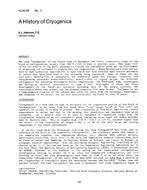Description
The term “cryogenics” is now widely used to designate the lowest temperature range in the field of refrigeration, roughly from –240°F (–150°C) down to absolute zero. This paper will relate the efforts of the early pioneers to liquefy the atmospheric gases and the development of techniques and equipment to achieve very low temperatures. These developments have led not only to wide industrial applications in many fields but have revealed many unusual phenomena in nature that have been used or are currently being exploited. Some of these are the wide-scale liquefaction of atmospheric and industrial gases for storage, transport, and refrigerating purposes; superconductivity, superfluidity of liquid helium, the dilution refrigerator for achieving millidegree Kelvin temperatures, the “hydrogen†bomb, cryosurgery and biological material preservation, to name a few. Highlights of these and other developments in the field are recounted including many of the people involved, the laboratories where they worked, and the pioneer companies that were formed. The paper is not a comprehensive treatise on the subject but tells the story from the knowledge, experience, and viewpoint of the author, who has been associated with the field for over 35 years.
Citation: Symposium, ASHRAE Transactions, 1984, vol. 90, pt. 2B, Kansas City, MO
Product Details
- Published:
- 1984
- Number of Pages:
- 16
- File Size:
- 1 file , 2 MB
- Product Code(s):
- D-KC-84-08-4




